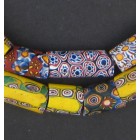

Antique Millefiori Beads (c. 19th Century)
Millefiori Beads (also known as “Mosaic Beads”) are a type of Venetian Trade Bead mass produced in Murano, Italy during the late 18th and 19th Century. The term “millefiori” is an amalgamation of the Italian words “mille” (thousand) and “fiori” (flowers), and was first used in A. Pellatt’s book “Curiosities of Glassmaking” in 1830.
The term “millefiori” refers to the floral design of the beads, which are created from multi-colored glass rods known as “murrine”. Glass rods used for the production of Millefiori Beads differ to those used for Venetian Chevron Beads in that they are composed of many smaller rods fused together in a design only viewable when the ends of the cane are cut. To make the beads, the murrine rods are heated in a furnace and pulled until thin, then fused with several more to create the structure of the bead. The exact positioning of the rods would determine the symmetry of the ‘flowers’, and only the most skilled of Venetian artisans were allowed to produce Millefiori Beads for trade.
Venetian Millefiori Beads were imported in their thousands to Africa from the mid 19th Century. They were an essential component of trade, being used as currency in exchange for furs, palm oil and spices in Mali and Western Africa. Since many African tribes were unfamiliar with glass-making technology, these beads represented a new and beautiful objet d’arts – primarily for self-adornment. Millefiori Beads have been incorporated into many traditional rites and ceremonies in Africa. In Ghana, young women are presented with strings of these beads during the Krobo Dipo ‘coming of age’ ceremony. Old Millefiori Beads are distinguishable by their pitted ends and slightly curved shape – often leading them to be called “Elbow” Millefiori Beads”.
References
Millefiori History, Wikipedia
Goulimine Beads, Inside Mystery